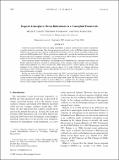Tropical atmosphere - Ocean interactions in a conceptual framework
Author(s)
Jansen, Malte Friedrich; Dommenget, Dietmar; Keenlyside, Noel
DownloadJansen-2009-Tropical atmosphere.pdf (2.154Mb)
PUBLISHER_POLICY
Publisher Policy
Article is made available in accordance with the publisher's policy and may be subject to US copyright law. Please refer to the publisher's site for terms of use.
Terms of use
Metadata
Show full item recordAbstract
Statistical analysis of observations (including atmospheric reanalysis and forced ocean model simulations) is used to address two questions: First, does an analogous mechanism to that of El Niño–Southern Oscillation (ENSO) exist in the equatorial Atlantic or Indian Ocean? Second, does the intrinsic variability in these basins matter for ENSO predictability? These questions are addressed by assessing the existence and strength of the Bjerknes and delayed negative feedbacks in each tropical basin, and by fitting conceptual recharge oscillator models, both with and without interactions among the basins.
In the equatorial Atlantic the Bjerknes and delayed negative feedbacks exist, although weaker than in the Pacific. Equatorial Atlantic variability is well described by the recharge oscillator model, with an oscillatory mixed ocean dynamics–sea surface temperature (SST) mode present in boreal spring and summer. The dynamics of the tropical Indian Ocean, however, appear to be quite different: no recharge–discharge mechanism is found. Although a positive Bjerknes-like feedback from July to September is found, the role of heat content seems secondary.
Results also show that Indian Ocean interaction with ENSO tends to damp the ENSO oscillation and is responsible for a frequency shift to shorter periods. However, the retrospective forecast skill of the conceptual model is hardly improved by explicitly including Indian Ocean SST. The interaction between ENSO and the equatorial Atlantic variability is weaker. However, a feedback from the Atlantic on ENSO appears to exist, which slightly improves the retrospective forecast skill of the conceptual model.
Date issued
2009-02Department
Massachusetts Institute of Technology. Department of Earth, Atmospheric, and Planetary Sciences; Massachusetts Institute of Technology. Program in Atmospheres, Oceans, and ClimateJournal
Journal of Climate
Publisher
American Meteorological Society
Citation
Jansen, Malte F., Dietmar Dommenget, and Noel Keenlyside. “Tropical Atmosphere–Ocean Interactions in a Conceptual Framework.” Journal of Climate 22.3 (2009) : 550-567. © 2009 American Meteorological Society.
Version: Final published version
ISSN
0894-8755
1520-0442